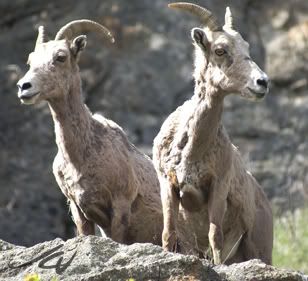
The oldest Bighorn Sheep fossils found in North America are about 100,000 years old. The race or subspecies known as the California Bighorn (Ovis canadensis californiana) inhabits the southwest interior of British Columbia and extends southward on the east side of the Coast and Cascade ranges into northern California. At one time, there were 1.2 - 2 million Big Horn Sheep in North America. During the late 1800s, overhunting decimated many Bighorn Sheep herds in British Columbia. It is estimated that there are 18,000 in BC, AB and Montana. BC's population is estimated at 3,300 to 3,625 in 1998 when the last count occurred.
The bighorn’s name comes from the adult ram’s massive, brown, spiralled horns that curl back and down close to the head, with tips that project forward and outward just below the eyes. The horns continue to grow throughout the sheep’s life, but growth slows down in winter. This causes check lines, or annuli, whose number shows the ram’s age. Ram horns can be as long as 127 cm around the curve and as thick as 40 cm around the base. Rams often wear away (or broom) the first year or two's growth by fighting with other rams or rubbing their horns against rocks. Ewes have slightly curved horns about 30 cm long. Their annuli are too close together to tell their age beyond five or six years
Both California and Rocky Mountain Bighorns are considered vulnerable and “at risk” in British Columbia, which means that without further protection, they are likely to become either threatened or endangered. Today, the Province of British Columbia allows the 'harvesting' of these beautiful and disappearing animals. For $29,500 plus TAX one is provided a 13-14 day trip to kill a Ram.
No wonder BC doesn't want to have legislature to protect the wildlife.

No comments:
Post a Comment